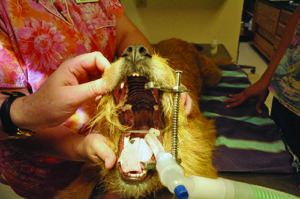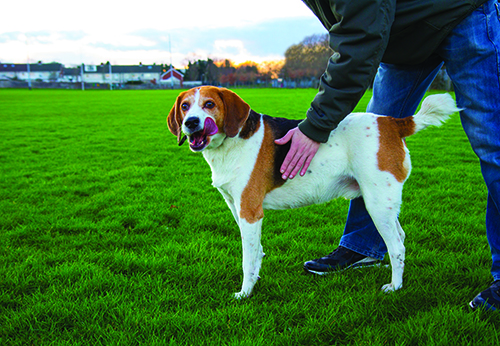Gastric ulcers can be a pain – causing indigestion, reflux, and discomfort. But did you know that your canine friend can also develop this problem? It’s true!
The problem with gastric ulcers in dogs is that they can’t tell us when they have heartburn. The symptoms can be very subtle and may often be misdiagnosed or overlap with other conditions. Further, the problems that are often associated with ulcers in humans (stress and Helicobacter pylori infections) are not well-described or understood in dogs.
Canine ulcers are usually gastroduodenal – meaning they are located in the stomach and upper intestinal tract, specifically the duodenum.
The stomach is comprised of four layers: The innermost is the mucosa, which is generally protected from the stomach acid by several important physiological mechanisms. The next layer is the submucosa, then the muscularis, the muscle that moves and contracts to cause peristalsis, the movement of the gastrointestinal (GI) tract. Lastly, on the outside, is the serosa.
An ulcer is a spot in which the normal, healthy tissue has been eroded away. The spot becomes irritated and friable, and bleeds easily. Ulcers can involve only the mucosa or can go full thickness through to the serosa (or any layer in between). When the serosa is involved, the ulcer is considered perforated, as now the stomach contents can leak outside of the GI tract.
SYMPTOMS
The symptoms of a canine ulcer are varied and include decreased appetite, frequent burping or regurgitation, lip licking and drooling, vomiting with fresh or digested/dark blood, weight loss, abdominal pain, and dark, tarry stool (called melena). Of these, about 90% of dogs will present with vomiting.
Because these symptoms can represent an extremely large variety of problems, a thorough physical examination with your veterinarian is the first step in addressing these concerns.
There are no specific breed, sex, or age differences in patients with gastric ulcers. It is interesting to note, however, that extremely athletic dogs such as Iditarod sled dogs do have a higher prevalence of gastric ulcers. If you have an agility dog with these symptoms, gastric ulceration should be on the list as a possible cause. It is not well understood why this is the case.
Helicobacter pylori is well known as a cause of gastric ulceration in humans. This bacteria infects over 50% of people, though many never have symptoms.
H. pylori has also been isolated in dogs. However, its significance in relation to gastric ulcers in dogs is unknown. The GI tract of some dogs can be populated with H. pylori even though the dog never has symptoms of GI problems, while others have symptoms but no
H. pylori.
If gastric ulcers are present, and a cause cannot be found, H. pylori may be the culprit. It can be diagnosed either with a biopsy taken during endoscopy or by appropriate empirical therapy. Treatment is a month of the antibiotics metronidazole and amoxicillin, as well as antacids such as famotidine (Pepcid) or omeprazole (Prilosec).
CAUSES
There are a number of things that can cause ulcers in dogs.
NSAIDs/corticosteroids. The best-known cause of canine ulcers is the use of non-steroidal anti-inflammatory drugs (NSAIDs) and corticosteroids (such as prednisone and dexamethasone).
These drugs are amazing and useful for many conditions like acute injury and arthritis. As a result, they are prescribed frequently. Both decrease inflammation by inhibiting prostaglandins (PGs). However, if the dog’s prostaglandin levels are decreased too much and/or for too long, stomach ulceration can occur, since PGs are critical for maintaining a healthy stomach barrier against acid.
While NSAIDs are extremely beneficial drugs for the management of pain, they do not come free of side effects and risks. Therefore, when managing painful conditions, it is reasonable to start with alternative and complementary therapies such as physical therapy, joint supplements (e.g., glucosamine and chondroitin), fish oils, and acupuncture prior to using NSAIDs.
Unfortunately, steroids are critical for the management of certain autoimmune conditions such as immune-mediated hemolytic anemia and thrombocytopenia. In those cases, they cannot be avoided, so monitoring for the symptoms of gastric ulceration is critical.
Important: Steroids and NSAIDs should almost never be used in combination. There are rare cases such as autoimmune diseases where high doses of steroids will be used with very low doses of aspirin, but these are specific conditions. In most cases, the two should never be administered together. Doing so significantly increases the risk of life-threatening ulcers.
It is also crucial to remember not to administer over-the-counter products to your dogs. Ibuprofen, naproxen, meloxicam, ketorolac, and aspirin are all human NSAIDs. These can be extremely toxic to dogs, leading to gastric ulceration and kidney failure.
Endocrine disorders. Both Addison’s disease (a lack of cortisol) and Cushing’s disease (an excess of cortisol) are known to predispose to gastric ulceration. If your dog has either of these conditions, your veterinarian should be on the lookout for gastric ulcers.
Acute and chronic kidney disease. As kidneys fail, the body loses its ability to rid itself of toxins. Gastric acid levels go up, leading to ulcers. The signs of kidney disease can be exactly the same as that of ulceration, so treatment for both is usually started.
Tumors. Mast cell tumors are common in Boxers and other breeds. They secrete histamine (responsible for allergic reactions), which increases gastric acid secretion and predisposes to ulcers. Gastrinomas are tumors found in the stomach and will also release large amounts of gastric acid.
Other, less common causes. These include liver disease, inflammatory bowel disease, foreign bodies, and ingestion of caustic materials.
DIAGNOSIS
If your dog has symptoms of gastric ulceration, the first step is consulting with your veterinarian. A thorough physical exam and diagnostics are needed to rule out many of the above causes. This will include a nose-to-tail physical and bloodwork such as a complete blood count and a chemistry panel.
Findings may include anemia and low proteins (from blood loss though the ulcer) and an elevated blood urea nitrogen (BUN). In some cases, white blood cell counts may be elevated in response to inflammation.
Other tests that your veterinarian may be able to do include a barium study and abdominal ultrasound. In a barium study, a large amount of bright contrast is given to a dog by mouth. Radiographs are taken immediately and then at various predetermined intervals. The barium shows up bright white on x-ray. It can show defects in the stomach.
Ultrasound can also be used to evaluate for ulcers, although they can be very difficult to see. If a stomach mass such as a gastrinoma is causing the ulceration, then ultrasound may be able to identify it.
Specialized testing can more definitively diagnose an ulcer. Endoscopy is the gold standard, but this isn’t available at many clinics. Generally, you must be referred to a specialist for an endoscopy, which will be done under anesthesia. While asleep, a camera is passed down the esophagus and into a dog’s stomach and upper small intestine. Frequently small samples are taken (biopsy) for definitive diagnosis. The results can take one to two weeks.
TREATMENT

Treatment for gastric ulceration depends on the underlying cause. If one is not found, then general treatment includes antacids, a bland diet, and gastroprotectants such as sucralfate. If a bacterial cause is considered (see “H. Pylori and Canine Ulcers,” page 7), then a specific therapy with antibiotics is recommended.
The major classes of antacids are proton pump inhibitors (PPIs) and H2 blockers. Both work in slightly different ways to lower gastric acid production. Famotidine (Pepcid) is an H2 blocker, while omeprazole and pantoprazole are PPIs.
Carafate (sucralfate) is another drug frequently used in the management of ulcers. It is a soothing agent that coats ulcerated areas. It is given as a tablet dissolved in water (a slurry). It can be give up to three times a day for relief of discomfort.
Other approaches may include a bland diet such as boiled chicken and rice. Probiotics can be added to food to maintain normal GI flora populations. Slippery elm and ginger may have some positive effects on GI ulcers, as well.
Perforated ulcers are severe, life-threatening emergencies. A perforation occurs when the ulcer has eroded completely through all four layers of the stomach or intestine. This allows leakage of bacteria-laden stomach and intestinal fluid into the abdominal cavity, leading to massive inflammation, infection, and sepsis. Treatment for perforated ulcers includes stabilization of shock and infection followed by surgery to repair the ulcers.
PROGNOSIS
Prognosis varies and depends on the underlying cause. For uncomplicated ulcers and ulcers related to H. pylori, prognosis is good with appropriate treatment. It is important to know that they can recur. Discontinuation of NSAIDs and steroids (when possible) will improve the prognosis for cases related to these medications. In the case of perforated ulcers, prognosis is guarded.
After nine years in emergency medicine, Catherine Ashe, DVM, now works as a relief veterinarian in Asheville, NC, and loves the GP side of medicine.







Thanks for the useful and necessary information!
Really interesting information. Our female labrador is on NSAIDs for arthritis, and now Omeperazole for reflux and suspected ulcers. Very helpful, thanks!
Very informative article. My 17 month old Rottweiler was diagnosed with pancreatitis and was on 4 different meds, 2 of which you stated in the article. She had several of the same symptoms, after following the Drs. orders for 5 days she now has to be on special food. I wonder if the pancreatitis will return. We rushed her to the vet as soon as the symptoms started. Anyone have some advice to keep her healthy, please let me know.
Our dog was diagnosed with pancreatitis as well. It hasn’t returned (yet. Knock on wood), but I don’t feed her any table scraps, I boil carrots for occasional treats (no store bought treats), and we are feeding her Royal Canine Low Fat food. She’s been doing great so far. I also have veterinarian proscribed probiotics if I see any changes in her poo.
This is a very informative article, thanks!
I have a five-year-old Boerboel who for the last three years has had weekly episodes of hypersalivation with lots of licking, belching, and drooling. These episodes frequently last for up to four hours during which time she loses a ridiculous amount of fluid through salivation. She has a great appetite, her poo is light-colored and consistent from day to day, and she never seems to be in pain. She very occasionally vomits foamy bile, but that’s more frequent when she misses breakfast or dinner. When it’s happening she does act slightly distressed; almost like she is car-sick. I posted a YouTube video on her channel, ‘Mavis & Me’, hoping somebody else might have an answer. My vet was stumped and couldn’t give me an answer. I don’t know exactly what kicks off an episode because they are pretty random, but they seem more likely when she’s stressed, after eating, after drinking cold water, and after coming into a warm house from being outside in the cold. They seem more frequent during the winter months, than the summer months. Anybody have any suggestions? Comments are open on my YouTube video, I’d love to hear your thoughts!
Hi. My almost 11 year old Lab has had similar symptoms on and off. He drips tons of saliva and licks his lips. He can’t seem to get comfortable and sometimes runs out in the yard to lay on the cool grass. We thought it may be triggered by stress but it seems to occur more frequently after a meal. Today we brought him to the vet to get a full blood work up and check his pancreas. We are awaiting the results. In the meantime, the vet has prescribed omeprazol and misoprostol to treat a possible ulcer. Good luck with Mavis.
This happend to our English Masiff… she went undiagnosed for for a couple of weeks. Then, out of the blue she started throwing up coffee grounds and passing black tarry stools. She died the next day at the vet, and we found out it was a perforated ulcer. Don’t wait, don’t assume, get your dog to the vet immediately…
So sorry for your loss 🙁
amazing write up
Our beautiful 9 yr old golden retriever who takes no other medications starting occasionally vomiting once every few days had bouts of loose stool didn’t improve saw vet bloods showed pancreatitis, abdominal scan clear… a month on occasional once a day vomiting every 4 days contained back to vet referral to specialist
Saw specialist bloods normal CT scan showed thickening around pyloric area, proceeded to endoscopy that showed severe ulcerative lesions and modular inflammation looking suspicious of a malignancy
Biopsies taken awaiting results but likely she has cancer
We won’t put her through a gastric resection and will love and care for her for as long as she isn’t symptomatic, already the drugs to address the ulcers is working
We are praying she doesn’t have cancer but accept what is likely coming. I’m so relieved I pushed for the referral so we can start trying to relieve the symptoms and make the right decision for her
The vets tell me something causes ulcers as in a disease process and it would be wonderful if what caused these ulcers could be managed